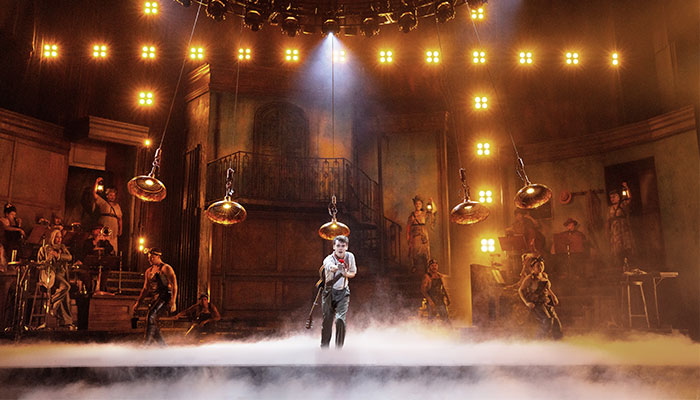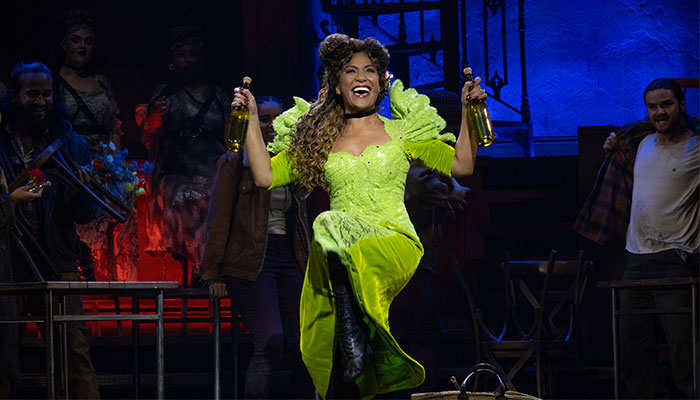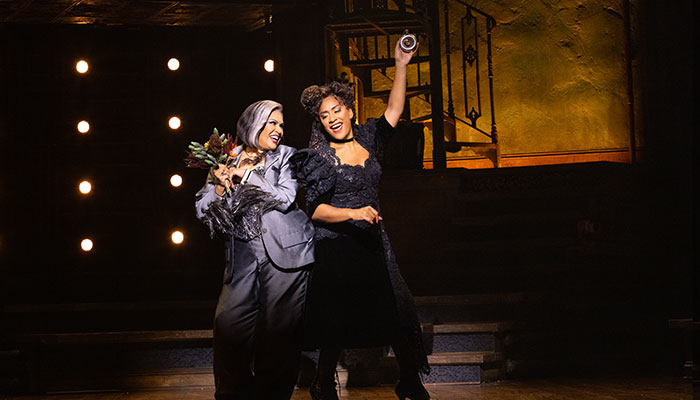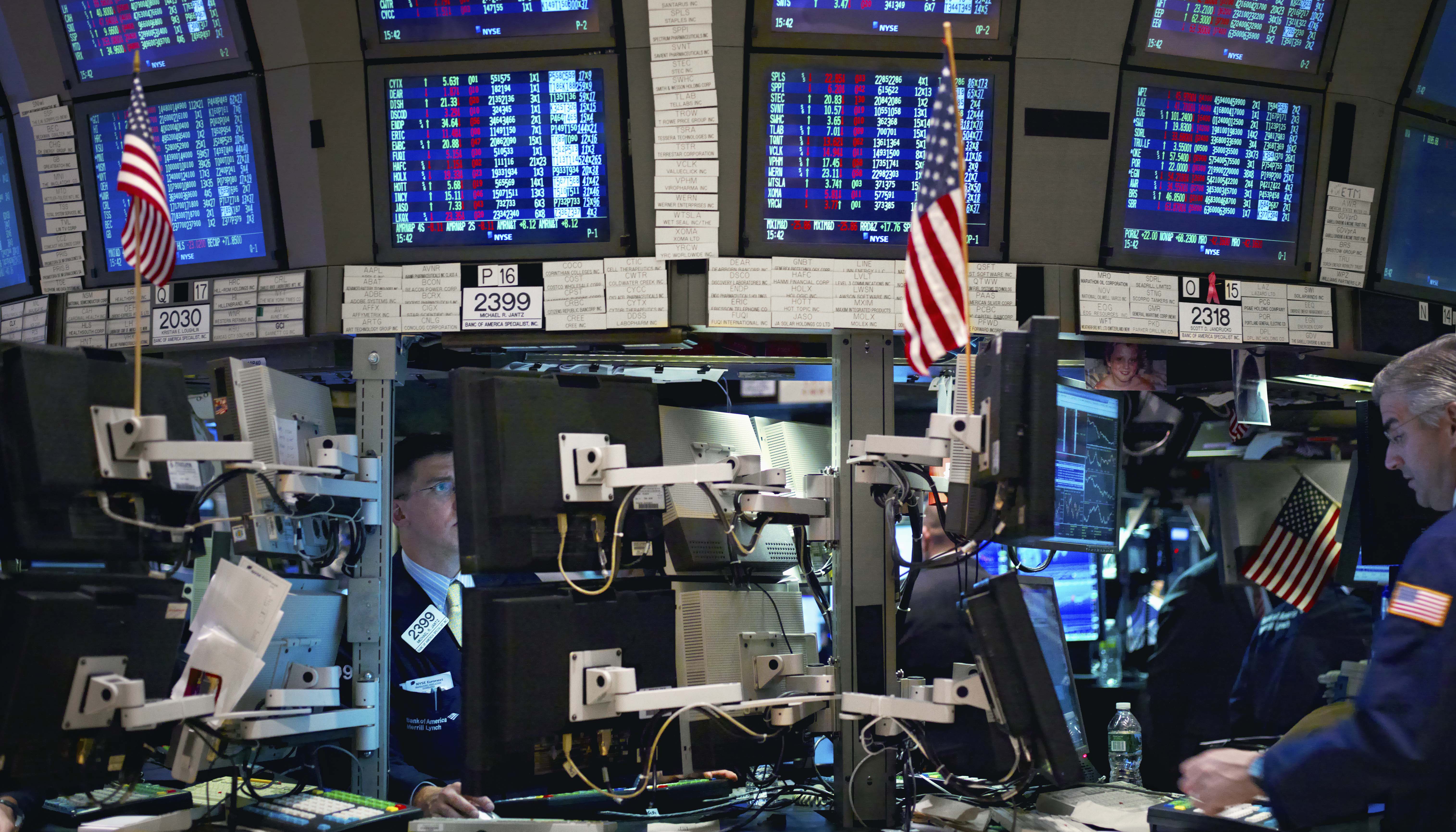The theatrical production of Hadestown, which revisits the ancient Greek myth of Orpheus and Eurydice, is not just an example of our tendencies towards familiar stories, retold in new ways: it takes the very form of our cyclical fascination with ancient mythical subjects and all the ways we can adapt, interpret, and retell them.

The cast performs Wait for Me in Hadestown, now playing at Sydney's Theatre Royal. Image: Lisa Tomasetti
Hadestown, originally written by singer-songwriter Anaïs Mitchell, reimagines the tragic story of Orpheus and his infatuation with Eurydice, intertwined with some elements of Hades and Persephone’s story.
Set in a mythical version of Depression-era New Orleans, the cast moves between a bar in the ‘real world’, where Orpheus (Noah Mullins) first falls in love with Eurydice (Abigail Adriano), and the realm of Hades (Adrian Tamburini) and Persephone (Elenoa Rokobaro), which is only a train ride away.
In the Underworld, an enslaved workforce is convinced by the king that their hoarded resources need to be protected from those in the real world who experience poverty. Eurydice’s background as a hunger-stricken, homeless teenager prompts her to sign the contract that Hades offers, beginning her descent into the Underworld and kicking off the mythically inspired conflict.
The show is visually stunning – the set design, which begins as a dark but lively Louisiana bar, is embellished with a wrought-iron balcony, and raised platforms placed around the stage that house the musicians, who are in costume and perfectly at home joining the cast on the main stage during the upbeat musical numbers.

Elenoa Rokabaro in Hadestown, now playing at Sydney's Theatre Royal. Image: Lisa Tomasetti
The narrative of Hadestown takes a few liberties with the mythical material, beginning with the Christianised renaming of the Underworld as Hell. This change heralds the alterations to the role of Hades himself: he is the primary antagonist of the story, playing an altogether more active part in the narrative than his usual mythical appearances.
His brash and demanding characterisation casts him as the villain, the greedy industrialist who offers poor substitutes to the natural world where Persephone craves to return. He is introduced in the first act as a haunting, omnipotent figure, and his musical contributions (“Why We Build the Wall,” in particular) resonate in an uncomfortable way with the contemporary era, where we must confront the increasing appearance of such attitudes.
The cast of Hadestown so successfully builds tension that even I felt my stomach drop at the summit of the tale.
Although the tyrant figure was certainly a popular bad guy in ancient writings, Hades was never the kind of god to involve himself so overtly in the affairs of mortals: I think we can consider this recent interpretation of the character a legacy of Disney’s Hercules, not the ancient Greek myths.
There is a constant thread throughout the performance that centralises the plight of the female character – a keen divergence from the ancient versions of the tale. Eurydice’s struggle to support both herself and Orpheus as he disappears into himself to write the song that will save the world; Persephone’s struggle to balance her desire for the upper realm and her capacity to settle Hades’ temper – these perspectives are worthy additions to the tale.
The show itself certainly feels mythic. Mrs Hermes (the incredible Christine Anu) watches over the performance, limited in her role as narrator, and yet perfectly representative of the role of gods in the ancient stories: involved, but not willing to extend the effort to change the outcome of events. The Fates (Sarah Murr, Jennifer Trijo, and Imani Williams) are entirely chaotic, prompting the story forward without a care for which side they’re aiding.

Christine Anu, left, and Elenoa Rokabaro, right, in Hadestown, now playing at Sydney's Theatre Royal. Image: Lisa Tomasetti
The finale of Orpheus and Eurydice’s story is well-known among those with an interest in the ancient Greek myths – and yet, the cast of Hadestown so successfully builds tension (especially through the heart-wrenching musical repetition of the main theme Wait for Me, and the clever, ever-shifting staging of Doubt Comes In) that even I felt my stomach drop at the summit of the tale. The outstanding performance had convinced me there might be a different ending.
Hadestown makes it clear that the ancient stories of gods and mortals are as relevant to us now as they were when they were first written. As the adaptation readily reminds us, “it’s an old tale from way back when, and we’re gonna sing it again and again.”
Dr Tanika Koosmen is an Associate Lecturer in the Department of History and Archaeology at Macquarie University.
Tickets: Hadestown is playing at Sydney's Theatre Royal until April 26, 2025.



